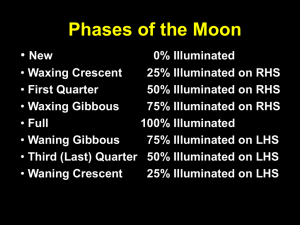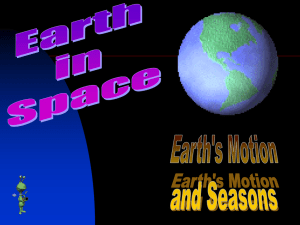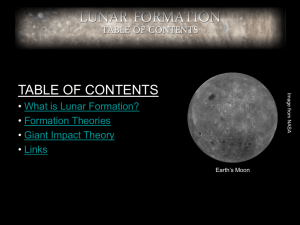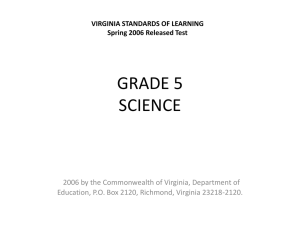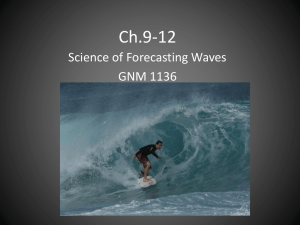The Moon - mrbemrose
advertisement
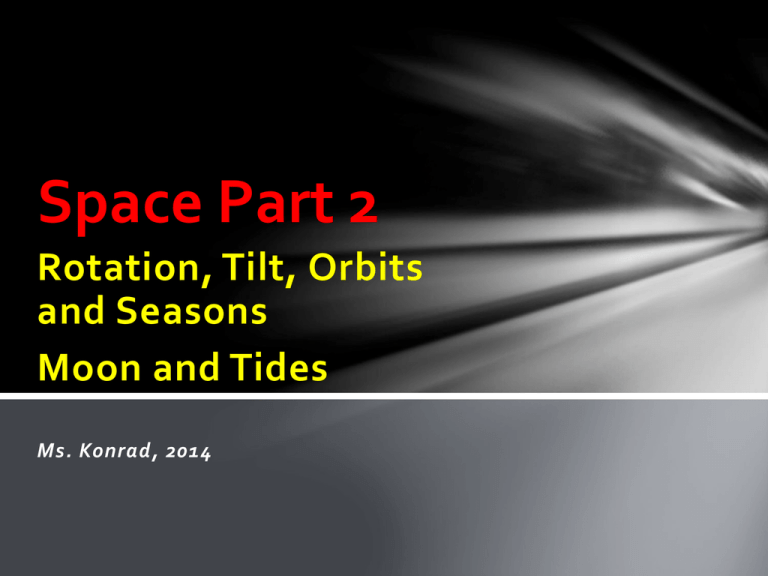
Space Part 2 Rotation, Tilt, Orbits and Seasons Moon and Tides Ms. Konrad, 2014 Learning Goals LG (4). Understand the relative movements of the earth, moon and sun. SC • I can draw a diagram showing the orbits of the earth, moon and sun, including their directions. • I can compare the rotation speed of the earth, moon, and sun. LG (5). Identify, through investigation, the effects of the following have on the weather conditions on Earth: the rotation and tilt of the Earth, and the Earth’s orbit around the sun. SC • I can explain how the sun creates day and night. • I can describe how and why the length of day varies due to the tilt of the earth and a person’s location on the globe. • I can explain what causes the seasons. • I can identify and explain the significance of the four equinoxes. LG (6). Investigate the phenomena caused by the relative locations of the Earth, Moon, and Sun. SC • I can draw a diagram to show the position of the Earth, Moon and Sun during both lunar and solar eclipses. • I can explain what a solar and lunar eclipse look like. • I can explain why we see the moon in different phases. • I can visually identify the phase of the moon as waxing, waning, new, or full. • I can explain what causes tides on Earth • I can tell you when to expect high and low tides, as well as spring and neap tides. • I can create a diagram and explanation of the Earth, Moon, and Sun’s locations during spring and neap tides. Orbits Orbit: the closed path a satellite takes around another body - All planets in our solar system orbit the sun - Moons orbit planets - DEMO (ball and string) Gravity: the force which pulls one mass toward another - Examples: - Human down toward the earth - Earth toward the sun - Moon toward the earth - Causes orbits, prevents satellites from flying off in a straight line Earth and Moon Orbits Radius of Earth: 6378 km (1 earth) Radius of Orbit (km) Radius of Moon: 1738 km (0.273 Earths) Radius of Sun: 695500 km (109 Earths) 1.60E+08 Speed of orbit (km/hr) Days/orbit 1.40E+08 120000 400 350 300 250 200 150 100 50 0 1.20E+08 100000 80000 1.00E+08 60000 8.00E+07 40000 6.00E+07 20000 4.00E+07 Earth 365 Moon 29 0 Earth 107 200 Moon 3 679.2 2.00E+07 0.00E+00 Earth Moon 1.5 x 108 3.85 x 105 Rotation and Tilt Axis of rotation: The invisible line around which a celestial body rotates Orbit: the closed path a satellite takes around another body Tilt: The angle at which the axis lies relative to the perpendicular of its orbital plane (cardboard cutout in the demo) Rotation: what effect does it have? Days/rotation 30 25 Earth: 1 day/rotation Sun: 25 days/rot Moon: 27.3 days/rot 20 15 10 5 0 Earth Moon Sun Tilt: what effect does it have? Earth: 23.5° Moon: 1.5424° Orbital/ http://www.nfo.edu/moonview.htm Axis Sun Perpendicular orbital plane Earth orbital plane orbital plane http://scienceblogs.com/startswithabang/2010/06/21/measure-the-tilt-of-the-earth/ Hemisphere Hemi = half Sphere = 3D circle Hemisphere = half-sphere Demo with half of a broken sun ball It is day on the side of the earth which faces the sun It is night on the side which faces away from the sun. http://www.abc.net.au/science/articles/2011/01/20/3116529.htm Globe and Light Demo (dots) What happens when the globe is tilted toward the sun? Away? Direct radiation: what happens when there is more? Length of Day and Seasons Longer days when our hemisphere is tilted towards the sun (summer). • More direct radiation. Shorter days when our hemisphere is tilted away from the sun (winter). • Less direct radiation Seasons Key Terms: Solstice, Equinox http://www.universetoday.com/27474/vernal-equinox-busting-the-myth-of-balancing-eggs/ Seasons Video http://www.youtube.com/watch?v=Pgq0LThW7QA http://www.youtube.com/watch?v=aSNs15sEINM https://drive.google.com/folderview?id=0B0E MJmndBs_EQ1RWYl9hbkNiZlE&usp=sharing Homework Reading: pg 320-328 Textbook Questions: pg. 328 # 2-11 http://www.moonconnection.com/moon_phases_calendar.phtml Phases of the moon http://upload.wikimedia.org/wikipedia/commons/c/c0/Lunar_libration_with_ phase2.gif Planetary http://www.youtube.com/watch?v=CJXsNmbTPSc • Like earth, one side of the moon experiences “day”, and the other “night” • The phase of the moon is its appearance at different locations in its orbit. • 1 full cycle of phases per month (29.5 day orbit) https://www.youtube.com/watch?v=uWOX7dgC2Bk Key phases Waxing moon: The bright portion is getting “larger” and sits on the right side Waning moon: The dark portion is getting “larger” and sits on the right side New moon: The moon is not visible (dark side faces earth) Full moon: The entire moon is bright and circular (light side faces earth) Phases of the Moon http://en.wikipedia.org/wiki/File:Moon_phases_en.jpg Eclipses Solar Eclipse: When our view of the sun is blocked out by the moon. Can only occur at a new moon, when the moon is between the Earth and Sun. Lunar Eclipse: When the moon is in the Earth’s shadow. Can only occur at a full moon, when the Earth lies between the moon and Sun. Hand Demo **Solar eclipses can only be seen from some locations on the earth. **Lunar eclipses are visible from anywhere with a view of the moon. http://www.iceinspace.com.au/63-682-0-0-1-0.html Solar Eclipse http://en.wikipedia.org/wiki/File:Solar_eclipse_1999_4_NR.jpg http://www.britannica.com/EBchecked/topic/178098/eclipse/11202/The-fre eclipses http://news.bbc.co.uk/2/hi/science/nature/8161578.stm Tides The gravity of the moon pulls the ocean water toward the Moon as it orbits causing tides to rise on that side. Spring tides: The largest tides. They occur when the Moon and Sun are in line with each other (on the same or opposite sides of the earth) so their gravitational forces combine (add up) Neap tides: The smallest tides. They occur when the Moon and Sun are on perpendicular sides of the Earth http://en.wikipedia.org/wiki/Tide Spring and Neap Tides http://blog.ucsusa.org/todays-king-tides-preview-the-future-of-sea-level-rise-162 Sources Hamilton, Calvin J.; Hamilton, Rosanna L., The Moon,Views of the Solar System, 1995–2011 Wikipedia: http://en.wikipedia.org/wiki/Orbit_of_the_Moon http://en.wikipedia.org/wiki/Earth http://en.wikipedia.org/wiki/Moon#cite_note-SolarViews-98 http://en.wikipedia.org/wiki/Lunar_eclipse


